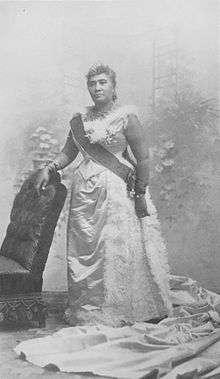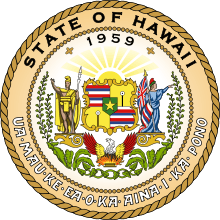Proposed 1893 Constitution of the Kingdom of Hawaii

The proposed 1893 Constitution of the Kingdom of Hawaiʻi would have been a replacement of the Constitution of 1887, primarily based on the Constitution of 1864 put forth by Queen Lili'uokalani. While it never became anything more than a draft, the constitution had a profound impact on Hawaiʻi's history: it set off a chain of events that eventually resulted in the overthrow of the Hawaiian Kingdom.
Background
Prior to 1887, the monarchs of Hawaiʻi ruled the kingdom as executive monarchs. Following the writing of the 1887 Constitution, however, the monarch was reduced to a mere figurehead.
During the 1890 legislature, the Hawaiian king, David Kalākaua, backed a number of proposals to amend or rewrite the 1887 constitution. However, all of these measures failed.
In 1891, Liliʻuokalani ascended the throne. In 1892, she backed measures in the kingdom's legislature to amend or rewrite the constitution. However, the measures failed as they had during the reign of her brother. Among the measures that failed was an amendment that would lower the property requirement to vote so most of the general public could vote. When that was voted down, many Hawaiian citizens protested.[1] Thousands petitioned the Queen to issue a new constitution as Kamehameha V had done in 1864 (the Constitution of 1864).
The Proposed Constitution
The constitution that Liliʻuokalani proposed differed from the 1887 constitution in the following respects:
- Members of the privy council, notary public, and agents would be able to run for the legislature.
- Princess Kaʻiulani, Prince Kawānanakoa and Prince Kalanianaʻole would be added to the line of succession.
- The Queen would be given the power to call meetings of the legislature.
- The legislature would meet for regular sessions in April instead of May.
- The Queen’s private lands and other property were made inviolable.
- The Queen would sign all bills before they became law. Under the 1887 constitution, any bills vetoed by the Queen and then repassed by the legislature with a two-thirds majority would automatically become law without the signature of the Queen. Under the proposed 1893 constitution, the Queen would be obligated to sign all bills repassed by the legislature with a two-thirds majority.
- The pay of the legislators would be increased from $250 to $500.
- Nobles would be appointed by the Queen instead of elected.
- The number of representatives could be increased from 24 to 48.
- Property requirements for voters were decreased.
- American and European residents, granted suffrage in 1887, would lose the right to vote.
- Supreme court judges would be appointed for six years instead of for life.
- The Queen would be able to appoint governors of each island for four years.
- Article 78 of the 1887 Constitution which required the monarch to performed "with the advice and consent of the Cabinet" was left out.[2]
Backlash
On January 14, 1893, the Queen met with her cabinet at ʻIolani Palace to discuss her proposed constitution. None of her ministers agreed to sign the constitution, believing that having the Queen simply proclaim a new constitution would spark unrest. The ministers went so far as to inform the Queen's political enemies of her plans, and were afraid of her threats of mob violence if they didn't follow her orders.[3] The Queen finally gave in late that afternoon, but the wheels of her overthrow had already been set in motion.
Outside, a large crowd of Native Hawaiians had gathered, expecting the Queen to proclaim a new constitution. However, after her meeting with her cabinet, Liliʻuokalani instead went outside onto the palace balcony and told the crowd that a new constitution would have to wait and that they should peacefully return to their homes.
That evening, a group of the Queen's opponents met to discuss the events of the day. Most were concerned over the Queen's attempt to restore the power of the crown. Some annexationists, like Henry Baldwin, urged moderation but others, like Lorrin A. Thurston urged the overthrow of the monarchy. A plan of action was created by the group, including the creation of a Committee of Safety, the overthrow of the monarchy, the establishment of a provisional government, and the petitioning for annexation to the United States.
The following Monday, the Queen issued a statement saying that she would not attempt to amend the constitution except by the means provided in the 1887 constitution. However, the Committee of Safety did not believe her promise was sincere, and continued with their planning. A group of men mostly drawn from the ranks of the Reform Party of the Hawaiian Kingdom formed the Committee of Safety and asked the United States Minister, John L. Stevens, to land troops from the U.S.S. Boston (anchored in Honolulu Harbor) into Honolulu, to protect American lives and property. John L. Stevens, reacting to what he saw as potential unrest as the internal crisis continued, requested the landing of about 160 Marines, who were given specific orders by Captain G. C. Wiltse to "land in Honolulu for the purpose of protecting our legation, consulate, and the lives and property of American citizens, and to assist in preserving public order."[4] At 2:00pm on January 17, 1893, a proclamation was read on the steps of Government building, declaring the monarchy overthrown. U.S. peacekeepers were at the time stationed at Arion Hall, the U.S. Consulate, and the U.S. Legation, under orders of strict neutrality and out of any potential line of fire between the Provisional Government and Royalist forces. The Queen abdicated under protest ostensibly "to the superior force of the United States government", though her surrender was delivered to the Provisional Government, not the United States. The Kingdom of Hawaiʻi had ended, and a new provisional government was declared.
The Provisional Government quickly gained recognition from the United States Government and all the other governments with embassies in Hawaiʻi,[5] but was opposed by the administration of Grover Cleveland for years as he attempted to restore the monarchy, beginning with the Blount Report. President Grover Cleveland, in a message to Congress on December 18, 1893, denounced the actions of Minister Stevens, the Honolulu Rifles and the Committee of Safety as an "act of war, committed with the participation of a diplomatic representative of the United States and without authority of Congress." Following the Morgan Report submitted by Congress on February 26, 1894, Cleveland reversed his stance, rebuffed the Queen's further requests for interference in the matter, and acknowledged the Provisional Government as legitimate.
Liliuokalani's trial
In 1895, an abortive attempt by Hawaiian royalists to restore Queen Liliʻuokalani to power resulted in the queen's arrest. She was forced to sign a document of abdication that relinquished all her future claims to the throne. Following this, she was subject to a public trial before a military tribunal in her former throne room.
Convicted of having knowledge of a royalist plot, Liliʻuokalani was fined $5000 and sentenced to five years in prison and hard labor. The sentence was commuted to imprisonment in an upstairs bedroom of ʻIolani Palace. During her imprisonment, the queen was denied any visitors other than one lady in waiting. She began each day with her daily devotions followed by reading, quilting, crochet-work, or music composition.
After her release from ʻIolani Palace, the queen remained under house arrest for five months at her private home, Washington Place. For another eight months she was forbidden to leave Oʻahu before all restrictions were lifted.
References
- ↑ Tarr, G. Alan (March 1985). "The Hawaii State Constitution: A Reference Guide". Journal of American History. 81 (4): 1863–1867.
- ↑ Kuykendall, Ralph Simpson (1967). The Hawaiian Kingdom 1874–1893, The Kalakaua Dynasty. 3. Honolulu: University of Hawaii Press. p. 586. ISBN 978-0-87022-433-1. OCLC 500374815.
- ↑ The Morgan Report, p960
- ↑ The Morgan Report, p.834
- ↑ The Morgan Report pp.1103-1110 includes all the letters of recognition given within 48 hours of the overthrow
- Potter, Norris W. and Kasdon, Lawrence M. Hawaiʻi, our Island State. Columbus, Ohio: Charles E. Merrill Books, Inc., 1964.
External links
| Wikisource has original text related to this article: |
| Part of a series on the |
| History of Hawaii |
|---|
 |
| Timeline |
| Modern-day Hawaii |
|
|